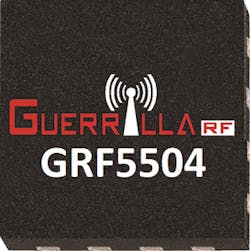When walking the show floor at IMS 2019, it was easy to spot the big names in the microwave industry with their large booths and various company representatives on hand. However, one shouldn’t forget about the contributions being made by smaller companies throughout the industry. For instance, a couple of them are making a big impact in the monolithic-microwave-integrated-circuit (MMIC) space, demonstrated by several new products announced in time for IMS.
Though it might be considered a smaller firm, Custom MMIC has established itself as a major player in the MMIC arena. At IMS, the company’s new CMD304 MMIC was front and center. The CMD304 is a gallium-arsenide (GaAs) distributed driver amplifier that operates from dc to 67 GHz. What’s impressive about the CMD304 is its flat gain over a wide frequency range (Fig. 1). At 30 GHz, the CMD304 achieves a gain of 9.5 dB, a noise figure of 3 dB, and an output 1-dB compression (P1dB) of +11 dBm.
1. Shown are the performance plots of the CMD304 distributed driver amplifier. The amplifier maintains flat gain over a frequency range of dc to 67 GHz.
Another relatively diminutive company that’s made a name for itself in the MMIC world in recent years is Guerrilla RF. While the company didn’t have a booth at IMS, several new product announcements were made in time for the show.
One announcement centered on Guerrilla RF’s first two power-amplifier (PA) products that utilize indium-gallium-phosphide (InGaP) heterojunction-bipolar-transistor (HBT) technology. The GRF5504 high-efficiency PA, which covers a frequency range of 400 to 500 MHz, delivers as much as 3.5 W of saturated output power (Fig. 2). With a bias voltage of +5 V, the GRF5504 provides a typical gain of 41 dB at 460 MHz. Applications for the GRF5504 include RFID and automatic meter readers.
2. The GRF5504 high-efficiency PA can deliver 3.5 W of saturated output power.
The second new InGaP HBT PA is the GRF5509, which covers a frequency range of 700 MHz to 1 GHz. The GRF5509 can deliver 5 W of saturated output power. At 915 MHz, it achieves a typical gain of 34 dB and has a power-added efficiency (PAE) of 58% at the saturated output power level. The amplifier is intended for the 900-MHz industrial, scientific, and medical (ISM) market, as well as automatic meter readers and RFID applications.
Guerrilla RF also announced the expansion of its AEC-Q100 Class 2 qualified component portfolio to satisfy the requirements of demanding automotive applications. This disclosure comes after the company revealed two automotive-qualified products back in February: the GRF2073-W ultra-low-noise amplifier and the GRF4002-W broadband low-noise gain block.
Following that development, Guerrilla RF announced that two additional products completed AEC-Q100 Class 2 qualification: the GRF2012-W broadband gain block and the GRF2501-W ultra-low-noise amplifier. The GRF2012-W offers low noise figure and good linearity over a frequency range of 700 MHz to 3.8 GHz. Specifically, at 900 MHz, the GRF2012-W achieves a noise figure of 2.7 dB and an output P1dB of +23 dBm when operating from a +5-V supply.
The GRF2501-W ultra-low-noise amplifier covers a frequency range of 4.9 to 6.0 GHz. With a bias voltage of 3.3 V, the amplifier’s gain and noise figure at 5.5 GHz are 17 dB and 1 dB, respectively. The company also stated that several other products will complete AEC-Q100 Class 2 qualification before the end of the year.



